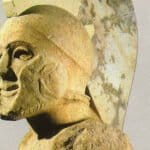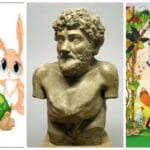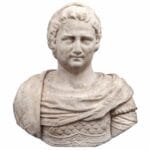Eros: Delving into the Primordial Depths of Desire
We are familiar with Cupid, the cherubic archer of Roman mythology, who embodies romantic love. Yet, his Greek antecedent, Eros, represents a far more primordial and intricate force. While Cupid flits about with hearts and flowers, Eros embodies the very essence of desire, from the fundamental urge for creation to the fiery passion that ignites art and the pursuit of knowledge.
In the swirling void before existence, the ancient Greeks envisioned Eros emerging from Chaos itself. He embodies the primal drive towards connection and creation, the impetus that brought forth the cosmos. While often associated with Aphrodite, the goddess of love and beauty – a natural pairing, given the interwoven nature of love and creation – Eros’s origins remain shrouded in mystery, suggesting a power perhaps even more ancient than the Olympian gods themselves. This primordial origin is explored in Hesiod’s Theogony, [https://www.lolaapp.com/greek-teller-of-fables] which depicts Eros as one of the first deities, born from the void.
Unlike Cupid’s playful, sometimes capricious nature, Eros commands awe and respect. He possesses wings, symbolizing the swift arrival of love and desire, and arrows that kindle passion in an instant. Yet, Eros’s power extends beyond sweet romance. He embodies the raw, untamed force of desire in all its manifestations. He can be a wellspring of joy and inspiration, but also a consuming fire, a transformative power that can reshape us entirely.
Envision the artist compelled to create, the scientist driven to unravel the universe’s secrets, the lover captivated by their beloved’s beauty – these are all manifestations of Eros’s influence. He propels our deepest yearnings, urging us to create, connect, and comprehend the world around us. He is the catalyst for our aspirations, the driving force behind our pursuit of the extraordinary. The story of Greek bacchanal depicts another powerful god, Dionysus, and his fervent followers.
Eros’s presence resonates through centuries of art, literature, and philosophy. From ancient Greek sculptures to Renaissance masterpieces, his image endures, a testament to his timeless power. Modern psychology, too, draws upon the concept of Eros, exploring how human desire shapes our actions and relationships. We continue to grapple with the same fundamental questions pondered by the ancient Greeks: What motivates us? What are our true desires? And what is the nature of love itself? The myth of Eros and Psyche, for instance, illuminates the transformative power of love, its inherent challenges, and the enduring strength of genuine affection.
Eros and Cupid: A Comparative Analysis
How does Eros compare to his Roman counterpart? The following table highlights their key distinctions:
| Feature | Cupid (Roman) | Eros (Greek) |
|---|---|---|
| Focus | Primarily romantic love | All forms of desire, creation, procreation |
| Portrayal | Mischievous child with arrows | Primordial force, youthful or mature |
| Nature | Playful, sometimes fickle | Powerful, awe-inspiring, transformative |
| Symbolic Meaning | Romantic affection, infatuation | Primal urge, creative force, driving force of existence |
These differences are not merely superficial; they reflect divergent cultural perspectives on love. For the Romans, Cupid represented the personal, often ephemeral experience of romantic attraction. For the Greeks, Eros embodied a fundamental cosmic principle, the very engine of existence. Some scholars suggest that this broader perspective on love might offer a more complete understanding of the human experience. There is ongoing debate, however, about the precise nature of Eros and his role within the Greek pantheon.
Eros: The Original Embodiment of Love and Desire
The term “Greek Cupid” is a simplification. Eros, the Greek god of love, desire, and attraction, is a far more complex figure than his Roman adaptation. While Cupid is associated primarily with romantic love, Eros embodies a primal force interwoven with the very fabric of the cosmos. In some accounts, he predates even the gods themselves. As Hesiod suggests, Eros sprang from Chaos, indicating that love, in its broadest sense, is a fundamental energy shaping the universe.
Eros’s connection to Aphrodite, the goddess of love and beauty, is frequently noted. While some texts portray him as her son, others present him as a primordial entity existing independently. This ambiguity adds another layer of complexity to his persona, fueling scholarly debate about his origins and true nature. His influence spans beyond romantic love, encompassing the passionate impulse behind all forms of creation, from the birth of stars to the composition of a symphony. This multifaceted nature is reflected in his varied depictions, ranging from a handsome youth to a more mature figure, suggesting the depth and complexity of love’s power.
Eros: The Driving Force of Creation
The Greek god of love is not simply a “Greek Cupid.” Eros is a force of profound significance, a primordial deity whose influence extends far beyond the realm of romance. He represents the driving force of creation, the very energy that brought the universe into being. He embodies not merely romantic love, but also procreation, sexual desire, and the raw, untamed passion that fuels life itself. His arrows, capable of igniting desire, can also inflict heartache, reflecting the complex and sometimes contradictory nature of love.
The Romans, in adapting Eros to their pantheon as Cupid, softened his image and focused primarily on the romantic aspects of his nature. While Cupid embodies a playful, often mischievous persona, Eros represents a deeper, more primal force. He is the raging fire of creation, while Cupid is the gentle flicker of romantic love.
It is important to acknowledge the evolving nature of our understanding of these ancient deities. Ongoing research continues to offer new insights into their complexities. Some experts believe Eros existed independently, others suggest a connection to Aphrodite. There is much we may yet discover about this enigmatic figure.
The following table summarizes the key differences between Eros and Cupid:
| Feature | Eros (Greek) | Cupid (Roman) |
|---|---|---|
| Origin | Primordial force of creation | Adaptation of Eros |
| Focus | Procreation, sexual desire, primal love, creative energy | Romantic love, desire, playfulness |
| Personality | Powerful, complex, sometimes chaotic | Mischievous, playful, romantic |
| Representation | Initially abstract, later a handsome young man with wings | Often a cherubic child with wings |
Exploring the myths and stories surrounding Eros and Cupid offers a deeper understanding of how ancient cultures perceived love, desire, and the human condition.
- Crypto Quotes’ Red Flags: Avoid Costly Mistakes - June 30, 2025
- Unlock Inspirational Crypto Quotes: Future Predictions - June 30, 2025
- Famous Bitcoin Quotes: A Deep Dive into Crypto’s History - June 30, 2025
















